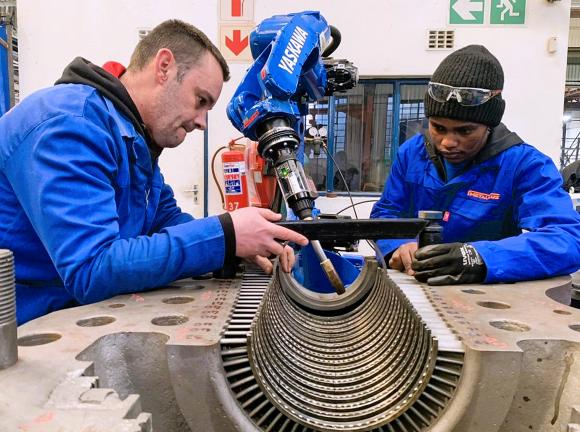Metalplus has successfully devised an innovative welding technique in which it has applied two welding systems to operate together in a seamless process.
In the latest project the robotic arm that forms part of Metalplus’ cold metal transfer (CMT) welding system was used to operate a combination of low temperature CMT welding and high current pulse multi-control (PMC) electric arc welding in a single process to achieve the required result.

“I believe this is the first time these two welding processes have been applied in this way in Southern Africa for turbine blade and shroud connection,” Roman Mornau, Metalplus’ Divisional CEO commented.
The welding repair work was a critical part of an emergency contract awarded to Metalpus’ sister division ACTOM Turbo Machines recently to repair a 3 MW power generation steam turbine deployed at a sugar mill in Kwazulu-Natal after it had failed during operation. ACTOM Turbo subcontracted Metalpus to weld the turbine’s shroud bands, which had been damaged during the failure.
“We devised the welding solution combining the CMT and PMC systems in a seamless robotically-controlled operation on the basis that it results in good penetration with strong fusion and still allows thin metal sections to be welded. The required procedure could be executed more rapidly and at substantially lower cost than any of the alternative methods available,” Roman explained.
Metalplus first put its combo repair method to the test by performing it on a test piece and then subjecting it to destructive testing by pulling apart the sample shroud band from the sample turbine blade. “The destructive test, performed by an independent SANAS-approved metallurgical laboratory, showed that the shroud band was able to hold more than 1.6tonne in the welded construction – four times the original design strength,” Roman pointed out.
A total of 1650 turbine blades had to be welded to 18 new shroud bands, which had been fabricated by ACTOM Turbo to replace the damaged ones.
“Each individual combination weld was performed within an exact timing sequence precisely programmed within 0.1sec increments, starting with a high current PMC electric arc weld at the base of the weld and switching without any delay to a low temperature CMT weld to complete the ideal weld geometry,” Roman said.
Metalplus performed its task, encompassing the preparatory testing and applying its unique welding solution, in a total of four weeks.
In combination with the welding work assigned to Metalplus to weld the new shroud bands in place, the work performed by ACTOM Turbo Machines on the failed turbine comprised:
- Removal of the damaged shroud bands by machining
- Manufacturing new shroud bands
- Final machining of all shroud bands to correct axial and radial clearances
- Nozzle labyrinth seal replacement
- Turbine rotor bearing journal and probe track refurbishment
- Turbine rotor dynamic low speed balancing
- White metal bearing refurbishment
- Bearing housing pin and key replacement
- Centreline pre-site assembly checks between turbine rotor, bearing housings, and refurbished main casing
ACTOM Turbo manufactured the new shroud bands by a reverse engineering process.
“This necessitated performing 3D scans of both the top and bottom casings to ensure correct references and sizes were adhered to,“ said Christopher Austin, ACTOM Turbo’s Service/Product Engineer.
“After completing manufacture and machining of the new shroud bands, we trial fit all 18 rows for each casing half to ensure the correct fit as well as blade pitching was achieved, as very little room for error was allowed with such a small blade surface to weld to.”
While Metalplus was carrying out the welding work, ACTOM Turbo performed the remainder of inspections and repairs required, as summarised above. After the shroud bands had been welded in place, ACTOM Turbo set up the top and bottom casings to enable it to machine all the shroud bands back to standard to ensure maximum operational efficiency of the machine.
“Finally, we conducted a centreline check of the casings and bearing housings in our workshop to trial fit the turbine rotor to make sure the extremely narrow 0.3mm clearance between the shroud bands and the rotor was correct,“ Christopher concluded.
ACTOM Turbo performed its scope of work within five weeks, as scheduled in the contract.
